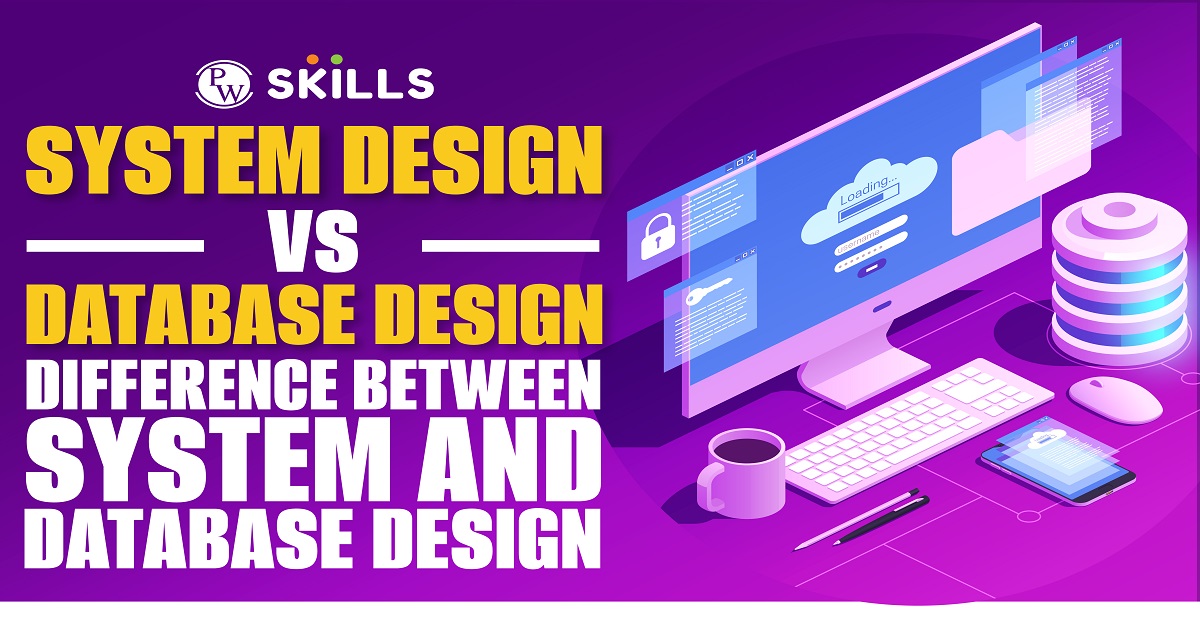System Design vs Database Design: System Design and Database Design are integral pillars in software development, each wielding its unique principles and considerations. This article explores the key differences and functionalities.
System Design vs Database Design: Are you overwhelmed trying to decipher the differences between system design and database design? You’re not alone! As technology continues to develop at a rapid pace, it can be hard to keep up with all of the changes. Fortunately, we’re here to help explain what distinguishes system vs database designs.
System design is an encompassing term for how computing systems should be created to achieve objectives-from installation and configuration through development and user experience.
On the other hand, database design is much more specific—it means designing databases so data can be easily managed and retrieved when needed. This blog post will discuss the main differences between these two vital aspects of computer science, as well as provide insight into their overlapping components – particularly from a compassionate perspective!
Learning about the differences between system and database designs can help IT professionals become more effective in their job by giving them greater insight into databases and architectures alike. To gain valuable insights into system and database designs, and System Design workshop by PW is a great starting point for all those who want to further dive into this fascinating field.
Also read: System Design Netflix – A Complete Architecture
System Design vs Database Design – Differences B/W These Designs
Here are the key differences b/w system design and database design:
| System Design vs Database Design | ||
| Criteria | System Design | Database Design |
| Definition | Comprehensive process of defining the structure, components, modules, interfaces, and data for a system to satisfy specified requirements. | Specialized process focusing on creating a structured repository for data storage, retrieval, and management. |
| Components | Encompasses hardware, software, networks, security, user interfaces, databases, and more. | Focuses primarily on tables, relationships, indexes, data types, and normalization. |
| Key Considerations | Hardware and software architecture, network design, security protocols, user interfaces, data flow, control flow, and system optimization. | Table structures, relationships between tables, indexing strategies, normalization, and data retrieval optimization. |
| Focus | Holistic view of the entire system and its interactions with external entities. | Concentrated on organizing data within the system for efficient storage and retrieval. |
| Questions Addressed | How different system components interact, overall data and control flow, system scalability, maintainability, and performance. | How data should be structured, relationships between data entities, how to ensure data integrity, and optimization of data retrieval. |
| Examples | Designing an e-commerce platform, including user interfaces, payment gateways, order processing, and database integration. | Designing a database for an e-commerce platform, defining tables for products, customers, orders, and relationships between them. |
| Interconnected Synergy | System design may dictate the need for specific database features or optimizations. The database is an integral part of the overall system architecture. | Database design is influenced by the requirements and architecture defined during system design. The effectiveness of the system depends on efficient data management. |
| Ultimate Goal | To provide a blueprint for the entire software ecosystem, ensuring it meets specified requirements and can evolve with changing needs. | To create a structured repository that facilitates data-driven functionality within the system. Effective data storage, retrieval, and integrity are paramount. |
| Architecture | Monolithic vs. microservices. | Choice between relational and NoSQL databases. |
Also read: How to Answer Any Machine Learning System Design Question?
System Design vs Database Design Interview Questions
Below are some interview questions that often arise when discussing System Design and Database Design:
System Design Interview Questions
- Explain the importance of system design in software development.
- What factors should be considered when designing a scalable system?
- How would you approach designing a system for high availability and fault tolerance?
- Discuss the difference between monolithic and microservices architectures. When would you choose one over the other?
- How can you ensure data security in a distributed system?
- Describe the concept of caching in system design. When is caching beneficial?
Database Design Interview Questions
- What is normalization, and why is it important in database design?
- Explain the difference between a primary key and a foreign key. Why are they crucial in database design?
- Discuss the benefits of indexing in a database. When would you create an index?
- How do you handle database transactions to ensure data integrity?
- Explain the concept of database normalization and its different forms.
Also read: A Detailed Guide on Cracking System Design Interviews in 2023!
FAQs
How does System Design address scalability?
System Design addresses scalability through strategies like microservices architecture, load balancing, and both horizontal and vertical scaling.
What is the significance of normalization in Database Design?
Database Design normalization is crucial for eliminating data redundancy and ensuring data integrity. It involves organizing data into tables to reduce redundancy and improve efficiency.
What are the key considerations in Database Design for performance optimization?
Database Design performance optimization involves choosing appropriate indexing strategies, optimizing queries, and considering caching mechanisms.
How does System Design ensure high availability and fault tolerance?
System Design ensures high availability and fault tolerance through redundancy, failover mechanisms, and distributed architectures.
In what scenarios would denormalization be considered in Database Design?
Database Design denormalization is considered when there is a need for faster query performance, and redundancy and data update complexities trade-offs are acceptable.
How does Database Design handle concurrency in a multi-user environment?
Database Design manages concurrency through techniques like locking mechanisms, transaction isolation levels, and optimistic or pessimistic concurrency control.
What role does caching play in System Design and Database Design?
Caching improves performance by storing frequently accessed data closer to the user in System Design. Caching in databases involves strategies like query caching or using in-memory databases to enhance query response times in Database Design.





